danbricklin.com/log
|
|||||||||
|
See also my Treo 180 review
|
RIM Keyboard
|
||||||||
Portable keyboards are in the news.
Research In Motion Limited (RIM) announced on April 11, 2000, a new version of their BlackBerry wireless device, the PDA-sized RIM 957. Last month, GoAmerica was letting attendees at the PC Forum 2000 conference borrow the older pager-sized RIM 950's supported by their service to try (I mention it on the Wednesday entry of my PC Forum 2000 Album). Both these devices have similar, very tiny keyboards. Through clever design, though, I have found them to be quite useful. Let me try to show you how the keyboard works. (The pictures and description refer to the RIM 950 unit sold by GoAmerica that I have.) At the end of this page, I have some speed comparisons with other input devices for portable equipment.
The RIM 950 is 3.5"x2.5"x0.93" and weighs under 5 ounces with its one AA battery:
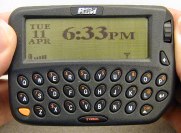 Here's the keyboard. The orange key on the left and the CAP key on the right are used as modifiers to let you type upper and lower case as well as the special characters. The little spacebar can also be used to access more characters. You type using your thumbs. There is a Backspace key, also used like ESC to go back through menus. The Enter key is used much like an Enter key on a PC:
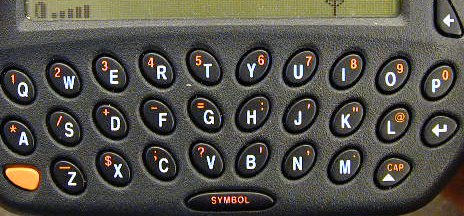 The keyboard, probably bigger than life size
Here is a closeup of the wheel on the upper right which acts as a pointing device. This really makes the unit work. It has little sharp edges that give it good traction on your fingers. It rolls with a nice click/click/click feel, like the wheel on the new mice. Pushing in on the roller wheel is like clicking a mouse:
 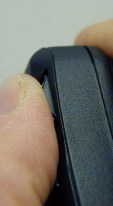 Roller wheel that makes the UI work well
Here's a look at some email messages:
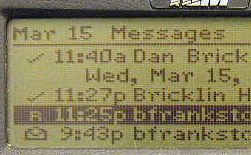 You can either press Enter to read the full text, or roll the wheel to it and then "click" to bring up a menu:
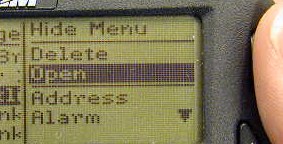 A menu
Another click opens the message. A roll of the wheel scrolls through:
  To send a message, click and roll to "Compose", click and then roll to select from the address book, then start typing:
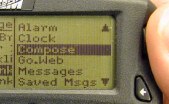 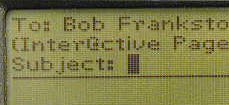 Here's the two-thumb typing. It goes surprisingly quickly if you know how to type on a QWERTY keyboard:
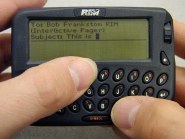 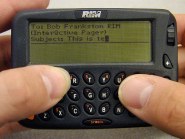 It will do abbreviation expansion. It is preset with "unshifted" versions of some special characters in common use:
  Auto-correct text (Function-J is apostrophe)
The keyboard is good enough that you can actually type more than a minimal amount, use punctuation, etc. The ease and speed of typing is a big surprise to everyone I've let try this keyboard.
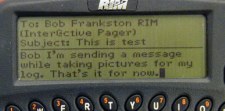 The GoAmerica unit came with their web browser. It has some built-in URLs, and you can set your own, have bookmarks, etc. One of the links I find useful is to TheTrip.com for airplane flight tracking. As you roll down through a web page, link after link is outlined (remember that one click-stop on the wheel doesn't have to move a line, it can just move you horizontally to the next link):
  The browser supports form items, but not tables or other fancy stuff. Here I'm filling in a flight number after rolling to a field and pressing Enter:
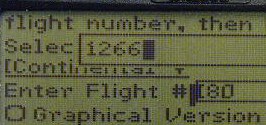 A press of Enter, and the field is filled out:
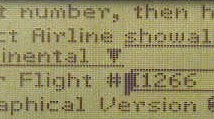 Point to a link, click, and choose "Goto Link" to browse (you can also just press Enter):
 The wireless system kicks in, sending the URL request, and receiving the new page:
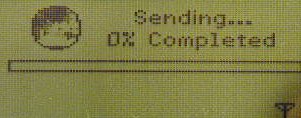 A few seconds later I have the response and scroll down to the flight information:
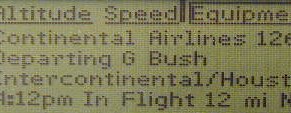 To test the speed of input, I entered "The quick brown fox jumped over the lazy dog's back." into three different input devices as quickly as I could: Graffiti on a Palm III using a pen, the RIM keyboard, and a Stowaway keyboard on the Palm III. (If you don't know about the folding Stowaway keyboard, read my "Stowaway Keyboard" writeup.) Here are the results after a little practice:
The Stowaway is about as good as most any laptop keyboard (maybe better since it is so thin that it lays lower on the table, which is supposed to be a better typing height). You can use your own typing speed in place of mine to relate these figures to yourself. If you have a Palm or Visor, you can run that test yourself, too -- I'm not too good at Graffiti, and don't usually get the speed or accuracy that I was able to achieve in this test under non-test conditions. I've only used the RIM for a little while (10 short letters?), but it's not too bad. Other people I've given it to have found that it was much faster to use than it looked. I think this is near an upper limit for me, though, and probably for many others (I don't have big fingers).
The bottom line? QWERTY rules! That is, unless you have a pen in hand and have little to write and just want to navigate, or want to use electronic "ink" to draw. I think that a combination of all three of these options (pen, tiny keys with roller, and foldable keyboard) would give you a no-compromise situation. The pen for navigation heavy read-only use, the tiny keyboard for short typing, and a foldable keyboard to take out and use with the unit when you have lots of notes to take or more than a short paragraph to write. It would be nice, too, if the foldable keyboard had a roller wheel for navigation. The wheel is really nice.
These input technologies open up new possibilities because they prove we can really use smaller devices. Costs of the devices are coming down and connectivity is going up which increases their usefulness. The PC is not the only device that should have a keyboard. The Stowaway design shows that lots of other devices could have periodic keyboards. The RIM design shows you can actually use something very small if it's designed right. The old situation where "only secretaries could type" has given way to all school children learn to type and most young adults and many older folks find typing faster than writing. A keyboard is now a "natural" device to use, like a telephone touchpad (and not like a dial phone which most children and teens don't know how to use) or a bicycle or a car. The great feel of the Stowaway and the surprising speed of the RIM open people's minds to the possibilities of small devices, much as the first good laptops did for a larger form factor, or the pen and the Palm Pilot did for pocket size.
|
|||||||||
|
© Copyright 1999-2018 by Daniel Bricklin
All Rights Reserved.
|
|||||||||